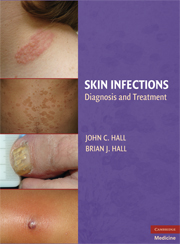Book contents
- Frontmatter
- Contents
- List of Contributors
- Acknowledgments
- INTRODUCTION
- TECHNIQUES IN DIAGNOSING DERMATOLOGIC MANIFESTATIONS OF INFECTIOUS DISEASES
- PRINCIPLES OF MANAGEMENT OF DERMATOLOGIC INFECTIONS IN THE SKIN
- PART 1 COMMON INFECTIONS
- PART II LESS COMMON INFECTIONS
- 4 CUTANEOUS TUBERCULOSIS
- 5 LEPROSY
- 6 ATYPICAL MYCOBACTERIA
- 7 ARTHROPOD-BORNE INFECTION
- 8 DEEP FUNGAL INFECTIONS
- 9 PARASITOLOGY
- PART III INFECTIONS IN SELECTED ECOSYSTEMS
- PART IV INFECTIONS IN SELECTED PATIENT POPULATIONS
- PART V INFECTIONS OF SPECIFIC SKIN-ASSOCIATED BODY SITES
- PART VI SPECIAL DISEASE CATEGORIES
- Index
8 - DEEP FUNGAL INFECTIONS
from PART II - LESS COMMON INFECTIONS
Published online by Cambridge University Press: 08 January 2010
- Frontmatter
- Contents
- List of Contributors
- Acknowledgments
- INTRODUCTION
- TECHNIQUES IN DIAGNOSING DERMATOLOGIC MANIFESTATIONS OF INFECTIOUS DISEASES
- PRINCIPLES OF MANAGEMENT OF DERMATOLOGIC INFECTIONS IN THE SKIN
- PART 1 COMMON INFECTIONS
- PART II LESS COMMON INFECTIONS
- 4 CUTANEOUS TUBERCULOSIS
- 5 LEPROSY
- 6 ATYPICAL MYCOBACTERIA
- 7 ARTHROPOD-BORNE INFECTION
- 8 DEEP FUNGAL INFECTIONS
- 9 PARASITOLOGY
- PART III INFECTIONS IN SELECTED ECOSYSTEMS
- PART IV INFECTIONS IN SELECTED PATIENT POPULATIONS
- PART V INFECTIONS OF SPECIFIC SKIN-ASSOCIATED BODY SITES
- PART VI SPECIAL DISEASE CATEGORIES
- Index
Summary
INTRODUCTION
Fungal diseases affect a considerable number of people world-wide and can cause significant morbidity and mortality. The number of cases has multiplied with the increase in world travel and immunosuppression. Generally speaking, fungal infections can be classified as either superficial or deep. Superficial fungal infections, including dermatophytes, have an affinity for keratin and, therefore, are typically limited to either the epidermis or adnexal structures. Deep fungal infections affect deeper structures, including internal organs.
Cutaneous manifestations of deep fungal infections occur from primary infection of the skin or from cutaneous dissemination due to a systemic infection.
Deep fungal skin infections are chronic diseases, caused by various groups of fungi. The clinical spectrum of these infections can be classified into (i) subcutaneous mycoses and (ii) systemic mycoses.
Subcutaneous mycoses are due to a large and diverse group of fungus that produce disease when traumatically introduced into the skin and subcutaneous tissue. Sporotrichosis, mycetoma, chromomycosis, and lobomycosis are the most common subcutaneous mycoses.
Systemic mycoses are caused by “true” fungal pathogens and opportunistic fungi. The “true” fungal pathogens are agents of histoplasmosis, blastomycosis, coccidioidomycosis, and paracoccidioidomycosis. The opportunistic deep mycoses comprise a spectrum of diseases, including zygomycosis, cryptococcosis, aspergillosis, phaeohyphomycosis, and hyalo-hyphomycosis.
Dermatologists from all over the world should be able to recognize and diagnose deep mycoses. Many of the deep mycoses, such as sporotrichosis, commonly occur in the United States, and others can infect travelers from endemic areas.
- Type
- Chapter
- Information
- Skin InfectionsDiagnosis and Treatment, pp. 96 - 116Publisher: Cambridge University PressPrint publication year: 2009

